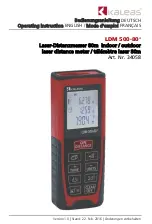
36
37
ISE SETUP (HI 5522 only)
Temperature Source
If using a temperature probe, sample temperature will be displayed with the “
ATC
” indicator displayed on the
LCD. The ATC option can be selected from Channel 1 or Channel 2. If no temperature probe is detected, a Manually
set value will be displayed (and logged) with the measurement.
Temperature Unit
Select the desired temperature unit (Celsius, Fahrenheit or Kelvin degrees) and the Meter will automatically
convert to the selected unit.
Manual Temperature
If no temperature probe is connected, the desired temperature can be manually entered. The default setting
is 25 °C.
Calibration
(Relative mV only)
Calibration Reminder
This option allows the user to select a calibration reminder schedule if desired.
See pH Setup section > Calibration Reminder section for option access details.
Set Reminder Period
See pH Setup section > Set Reminder Period section.
Clear Calibration
This feature deletes the Relative mV calibration for the selected channel.
• Press
while in Rel mV mode.
• Press
then use
or
to access Calibration option.
• Press
and use
or
to highlight Clear Calibration option.
• Press
to clear calibration. A pop-up menu will be displayed asking for confirmation (when a
calibration is available).
• Press
to confirm or press
to escape without saving and return to the Calibration options.
Sample ID
- See pH Setup section.
Stability Criteria
- See pH Setup section.
Reading Mode
- See pH Setup section.
Log
- See Logging section or pH Setup section.
Alarm
- See pH Setup section.
The ISE Setup menu allows the user to set the parameters regarding ISE measurement and calibration.
Accessing ISE Setup
• Press
while in
Measure
mode and then
to
select ISE range for the desired channel.
• Press
and then
to access ISE Setup menu.
To access an ISE Setup option:
• Use
or
to highlight the desired option.
• Press
to access the selected option.
The following is a detailed description of the ISE Setup option
screens.
Profile
- See pH Setup section.
Reading Mode
This option allows the user to select the desired reading mode: Direct, Direct/AutoHold, Known Addition, Known
Subtraction, Analyte Addition and Analyte Subtraction. Four of these Reading Modes are collectively known as
Incremental Methods (see ISE Theory section for details). Direct measurements and Direct/AutoHold measurements
are also possible.
Direct
Direct measurements are analogous to taking pH measurements. The ISE is calibrated in Ion standards and
sample measurements are made directly. The ISE’s manual should be consulted for tips and practices of making
Direct measurements. The Ion concentration can be read directly from the instrument.
Direct/AutoHold
Direct/AutoHold measurements are made similar to Direct measurements. The advantage of using AutoHold is a
measurement that has not reached equilibrium will not be used. Only after the chosen stability criteria has been
met will the meter go into the AutoHold mode. Using AutoHold removes the subjective nature of stability.
Known Addition
In the Known Addition method, a sample is measured with an ISE before and after the addition of a known volume
of a standard. The mV difference is then used to calculate the concentration of the Ion in the original sample.
w
w
w
.
.c
om
in
fo
rm
at
io
n@
itm
.c
om
1.
80
0.
56
1.
81
87
















































